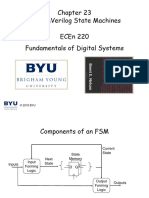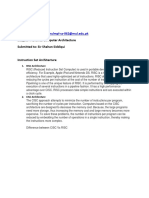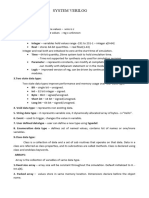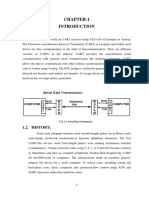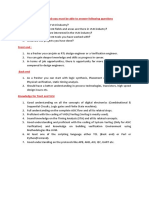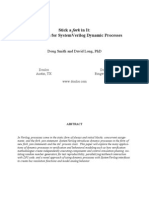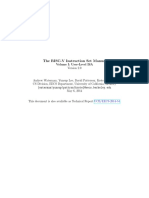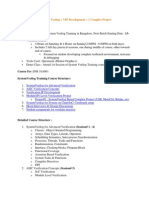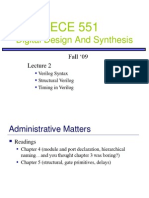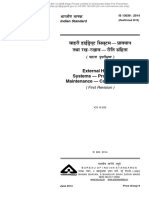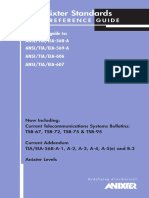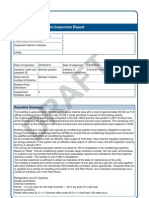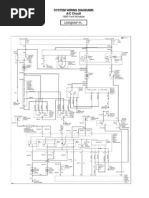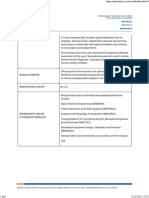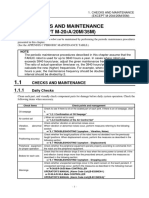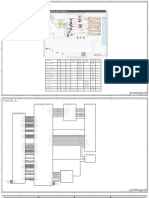VERILOG FOR SYNTHESIS
1.0 Verilog Synthesis Methodology
Synthesis is a contraint driven process i.e. the synthesis script needs timing constraints
Follow the following methodology for best results
1. Draw a simple block diagram, labelling all signals, widths etc.
2. Draw a timing diagram with as much detail as possible
3. Code the HDL according to the synthesizable templates
4. Do a quick, low effort, compile- just to see if it is synthesizable before simulating. Compare this to the block dia-
gram. Look at the inference report:
• count the number of flip flops - is it the same as the number of flip flops in the code.
• check for latches - did you want them. If not, latches are inferred in combinational procedures - the inferrence
report tells you which combinational procedure and the name of the latch. Fully specify all variables in all cases to
eliminate latches.
• Check the case statement inferrence. Was it full/parallel?
• Check any incomplete event list warnings?
• Check to see if there are any combinational feedback loops (typically only after a compile). Combinational feed-
back loops can be identified by the signal names in the timing loop.
• Check the schematic - any ports unconnected?
• Check to see if Designware and Ambitware components have been built correctly. Are these the components that
you wanted? How many did you want?
• Never ignore any warning that the synthesis tool flags. All warnings need to be understood and typically signed
off.
5. Simulate and compare with the timing diagram
• If your design doesn’t meet timing by more than 10% of the clock period, then go back to the code. If you are
within 10% of the clock period, then try a different compile strategy.
October 1, 2024 1
� VERILOG FOR SYNTHESIS
2.0 Synthesizeable Templates
2.1 Combinational Logic
a
b c
// Using a reg
//
wire a,b;
reg c;
always @ (a or b)
c = a & b;
// Using a wire
//
wire a,b,c;
assign c = a & b;
// using a built in primitive (without instance name)
//
reg a,b;
wire c;
and (c,a,b); // output is always first in the list
// using a built in primitive (with instance name)
//
reg a,b;
wire c;
and u1 (c,a,b); // output is always first in the list
// if c is an output
//
output c;
reg a,b;
assign c = a & b;
October 1, 2024 2
� VERILOG FOR SYNTHESIS
2.2 Multiplexers
2.2.1 Multiplexer using a procedure
// 1. using an always a
always@(a or b or sel)
1
b
if (sel == 1’b1) c 0
c = a;
else
c = b;
sel
Use default assignments
to prevent latches: every
2.2.2 Multiplexer using the ternary operator
// 2. using the ternary operator
wire c = sel ? a : b;
2.2.3 Multiplexer using the case statement
// 3. using the case statement a
1
always @ (a or b or sel) b
case (sel) c 0
1’b1: c = a;
1’b0: c = b;
sel
endcase
October 1, 2024 3
� VERILOG FOR SYNTHESIS
2.3 Priority Decoders
2.3.1 Priority Decoder using a case statement
// 1. using a case statement
always @ (sl or a or b or c) 1. Both case and if statements result in
priority structures.
case (sel)
2. The order of the variables determines
2’b11: d = a;
the priority
2’b10: d = b;
default: d = c;
endcase
sel
2’b10 2’b11
2
= =
c 0
0
b 1 d
1
a
October 1, 2024 4
� VERILOG FOR SYNTHESIS
2.3.2 Priority Decoder using an if/else statement
// 2. using an if statement
always @ (sl or a or b or c)
if (sel == 2’b11)
d = a;
else if (sel ==2’b10)
d = b;
else
d = c;
sel
2’b10 2’b11
2
= =
c 0
0
b 1 d
1
a
October 1, 2024 5
� VERILOG FOR SYNTHESIS
2.4 Parallel Priority Decoders
2.4.1 Parallel Priority Decoders Using a Synthesis Directive
// using a synthesis directive
always @ (sl or a or b or c)
case (sel) // parallel_case
2’b11: d = a;
2’b10: d = b;
default:d = c; sel
endcase
2
c 2’b0x
b 2’b10 d
a 2’b11
October 1, 2024 6
� VERILOG FOR SYNTHESIS
2.5 Bus Logic, Splitting and Reordering
2.5.1 Bus Enabling
// A1. using a wire
wire [3:0] d = ({4{enable}} & c);
// A2. using a reg
reg [3:0] d;
always @ (c or enable)
d = c & {4{enable}};
enable
d[3:0]
c[3:0]
4
4
October 1, 2024 7
� VERILOG FOR SYNTHESIS
2.5.2 Bus Concatenation
// B1. using a wire
wire [2:0] e = {a[1],b[3:2]};
// B2. using a reg
reg [2:0] e;
always @ (a or b)
e = {a[1],b[3:2]};
e = {a[1],b[3:2]}
a[3]
a[2]
a[1] e[2]
a[0] e[1]
b[3] e[0]
b[2]
b[1]
b[0]
October 1, 2024 8
� VERILOG FOR SYNTHESIS
2.5.3 Bus Replication
a[0] b[0]
a[1] b[1]
b[2]
b[3]
// bus replication
wire [1:0] a;
wire [3:0] b;
assign b = {2{a}};
October 1, 2024 9
� VERILOG FOR SYNTHESIS
2.6 Comparators
// 1. using a wire
wire d;
assign d = (a == c);
// 2. using a reg
reg d;
always @ (a or c)
d = (a == c);
a[3:0]
4
= 1
d
c[3:0]
4
October 1, 2024 10
� VERILOG FOR SYNTHESIS
2.7 D Type Flip Flops
// 1. positive edge triggered D flip flop
always @ (posedge clock)
q <= d;
d q
Use non-blocking assignments (<=) in
clock
clocked procedures.
// 2. negative edge triggered D flip flop
always @ (negedge clock)
q <= d;
d q
clock
October 1, 2024 11
� VERILOG FOR SYNTHESIS
2.8 Resettable D Type Flip Flops
// 1. synchronously resettable D flip flop
always @ (posedge clock)
if (reset)
q <= 1’b0;
else 1’b0
q <= d;
q
d
reset
clock
// 2. asynchronously resettable D flip flop
// (active high async reset)
always @ (posedge clock or posedge reset)
if (reset)
reset
q <= 1’b0;
else
q <= d; d q
clock
October 1, 2024 12
� VERILOG FOR SYNTHESIS
// 3. asynchronously resettable D flip flop
// (active low reset)
always @ (posedge clock or negedge reset)
if (~reset)
q <= 1’b0; reset
else
q <= d; d q
clock
October 1, 2024 13
� VERILOG FOR SYNTHESIS
2.9 Data Enabled and Clock Gated Flip Flops
// 1. data enabled flip flop
always @ (posedge clock)
if (enable)
q <= d;
q
d
enable
clock
// 2. D flip flop with gated clock
wire gclk = (clock && enable);
always @ (posedge gclk)
q <= d;
d q
clock
enable
gclk
enable signal must be
glitch free
October 1, 2024 14
� VERILOG FOR SYNTHESIS
2.10 Latches
// 1. latch
always @ (enable or d)
if (enable)
q = d; d q
enable
// 2.resettable latch
always @ (enable or d or reset)
if (reset)
q = 1’b0;
reset
else if (enable)
q = d;
d q
enable
October 1, 2024 15
� VERILOG FOR SYNTHESIS
2.11 Tri-state Drivers
// 1. using a reg
reg y;
always @ (d or enable)
enable
if (enable)
y = d; d y
else
y = 1’bz;
// 2. using a wire
wire y;
assign y = enable ? d : 1’bz;
// 3. using a primitive
bufif1 (y,d,enable);
October 1, 2024 16
� VERILOG FOR SYNTHESIS
2.12 Counter
3 bit asynchronously resettable counter which counts 0, 1, 2, 3, 4, 5,
// 3 bit asynchronously resettable
// partial range counter
always @ (posedge clock or posedge reset)
if (reset)
count <= 3’b0;
else
if (count == 3’b101)
count <= 3’b0;
else
count <= count + 3’b001;
reset
3’b001
3’b000 1 count
0 3
3
enable
=
3’b101 clock
October 1, 2024 17
� VERILOG FOR SYNTHESIS
2.13 Enabled Shift Register
data_out
data_in
clock
enable
module enabled_shift_reg (clock,enable,data_in,data_out);
input clock;
input enable;
input [3:0] data_in;
output [3:0] data_out;
reg [3:0] data_out;
reg [3:0] shift_reg_1;
reg [3:0] shift_reg_2;
reg [3:0] shift_reg_2;
always @ (posedge clock)
if (enable)
begin
shift_reg_1 <= data_in;
shift_reg_2 <= shift_reg_1;
shift_reg_3 <= shift_reg_2;
data_out <= shift_reg_3;
end
endmodule
October 1, 2024 18
� VERILOG FOR SYNTHESIS
2.14 Unsigned Adders and Multipliers
a
5
c
6
12
b e
5
6
d
Note that the * and + and - signs give you unsigned arithmetic. If you need signed arithmetic, you may need special
instaces recognizable to the synthesis tool.
• Adding two five bit numbers gives a siz bit result (the extra bit is the carry out bit).
• The multiplication of two number means that the output is twice the width of the inputs.
wire [5:0] c = a + b;
wire [11:0] e = c * d;
October 1, 2024 19
� VERILOG FOR SYNTHESIS
3.0 Coding Guidelines
These coding guidelines assume that you are able to write correct synthesizeable code. You can always check the
synthesizeablilty of your code by parsing it using the synthesis tool.
• Use non-blocking assignments (<=) in clocked procedures. Don’t use blocking assignments (=).
always @ (posedge clock)
q <= d;
• Use blocking assignments (=) in combinational procedures:
always @ (a or b or sl)
if (sl)
d = a;
else
d = b;
• Make sure that the event lists are complete
always @ (a or b) // this event list is missing signal sl
if (sl)
d = a;
else
d = b;
• Take care of indentation. Develop your own identation guidelines and stick to them. Make sure others can read
them. It helps readability and debugging greatly if it is done properly.
• Comment code properly. The theory about good commenting is that you should be able to remove all functional
code and the comments remaining should almost document the block you are designing.
// example of bad comments
// add a and b together
always @ (a or b)
c = a + b;
// Good commenting
// 8 bit unsigned adder for data signals ‘a’ and ‘b’
// output is sent to UART2
always @ (a or b)
c = a + b;
• Always completely specify literals.
always @ (c)
if (c == 4’b0101)
a = 2’bxx;
else
a = 2’b10;
• Use named port mapping when instantiating.
state_machine u1 (
.sm_in (in1),
.sm_clock (clk),
.reset (reset),
.sm_out (data_mux)
);
• Don’t make the code any more complicated than it needs to be. Your priorities should be correctness, then read-
ability and finally code efficiency.
October 1, 2024 20
� VERILOG FOR SYNTHESIS
4.0 State Machine Guidelines
4.1 Guidelines
• Draw a state diagram.
• Label the states.
• Allocate state encoding.
• Label the transition conditions.
• Label the output values.
• Use parameters for the state variables.
• Use two procedures (one clocked for the state register and one combinational for the next state logic and the out-
put decode logic).
• Use a case statement in the combinational procedure.
• Have a reset strategy (asynchronous or synchronous).
• Use default assignments and then corner cases.
• Keep state machine code separate from other code (i.e. don’t mix other logic in with the state machine clocked
and combinational procedures).
October 1, 2024 21
� VERILOG FOR SYNTHESIS
4.2 State Diagram
transition condition
ack = 1’b0 start ack = 1’b0
offline = 1’b1 IDLE offline = 1’b0
online = 1’b0 online = 1’b1
2’b10 RUN
2’b00
transmit state label
state encoding
wait stop
ack = 1’b1
PAUSE
offline = 1’b0
online = 1’b1 2’b01 output values
FINISH
2’b11 ack = 1’b1
stop offline = 1’b0
online = 1’b1
October 1, 2024 22
� VERILOG FOR SYNTHESIS
4.3 State Machine Verilog Code
module state_machine (clock,reset,start,transmit,wait,stop,ack,offline,online);
// parameter declarations
parameter pIDLE = 2’b10; // state labels and state encoding
parameter pRUN = 2’b00;
parameter pPAUSE = 2’b01;
parameter pFINISH = 2’b11;
// IO declaration section
input clock;
input reset;
input start, transmit, wait, stop;
output ack, offline, online;
// interal variables declaration section
reg [1:0] state, next_state;
reg ack, offline, online;
// clocked procedure with synchronous reset
always @ (posedge clock)
if (reset) // reset strategy
state <= pIDLE;
else
state <= next_state;
// combinational procedure with case statement and output logic
always @ (start or transmit or stop or wait or state)
begin
next_state = state; // default assignment to state and output variables
ack = 1’b0;
offline = 1’b0;
online = 1’b1;
case (state)
pIDLE:
begin
offline = 1’b1;
online = 1’b0;
if (start)
next_state = pRUN;
end
pRUN:
begin
if (wait)
next_state = pPAUSE;
if (stop)
next_state = pFINISH; // this has priority over the wait transition
end
pPAUSE:
begin
ack = 1’b1;
if (transmit)
next_state = pRUN;
if (stop)
next_state = pFINISH;
end
pFINISH:
ack = 1’b1;
endcase
end
endmodule
October 1, 2024 23



